Étienne-Jules Ramey (24 May 1796 – 29 October 1852), called Ramey fils, was a French sculptor.

Biography
editRamey was born in Paris. The pupil of his father, Claude Ramey (1754–1838), he also trained in the studio of Pierre Cartellier.[1] He won the Prix de Rome in sculpture in 1815 with the subject, equally classicizing and sentimental, Ulysses recognized by his dog.[1] He collaborated with David d'Angers on the sculptures for the triumphal arch at Marseille, the Porte d'Aix, 1828 to 1839.
He worked in partnership with Augustin-Alexandre Dumont and taught at the École nationale supérieure des Beaux-Arts in Paris. His pupils included the sculptors Guillaume Geefs, Jean-Joseph Perraud, and Amédée Ménard. He died in Paris.
His careful, mannered drawings appear on the market from time to time.[2]
Selected works
edit- Thésée combattant le Minotaure (1826), limestone group, Jardin des Tuileries, Paris
- Saint Luc, limestone Paris, peristyle of the rear façade of the Église de la Madeleine
- Saint Pierre and Saint Paul, limestone, Paris, Église Saint-Vincent-de-Paul, place Franz-Liszt
Notes
edit- ^ a b Plaster model exhibited The legacy of Homer (Emmanuel Schwartz, curator) École nationale supérieure des beaux-arts (France), Dahesh Museum of Art, Princeton University (2005-06), cat no. 78.
- ^ "a careful drawing by the sculptore, Etienne Jules Ramey, which recalls the work of Ingres at its most mannered" was noted in a review by J. J. L. Whiteley of an exhibition at Hazlitt, Gooden & Fox (London) and illustrated (fig. 72, "Aconce et Cydippe") in The Burlington Magazine 125 No. 965 (August 1983), pp. 506f.